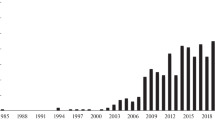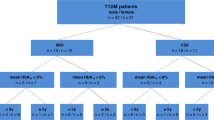Abstract
The effect of metabolic syndrome risk factors on the content of light hydrocarbons (C2-C3) in exhaled air has been studied with the participation of students of Novosibirsk State Medical University. Gas chromatography was performed in an EKHO-EW-FID chromatograph with a short multichannel column. The study revealed sex-related differences between the concentrations of light hydrocarbons in exhaled air. In addition, some factors, such as smoking and type 2 diabetes mellitus in relatives, affect the content of C2-C3 compounds in exhaled air of women only. However, overweight is correlated with the content of acetone (C3) in exhaled air only in men. Thus, the metabolic changes caused by the presence of age-specific metabolic syndrome risk factors lead to the changes in the gas composition of exhaled air and can be detected and used for early diagnosis.
Similar content being viewed by others
References
Balabolkin, M.I., Diabetes mellitus: Is It Possible to Control Its Spread and Frequency of Complications? Terap. Arkhiv, 1993, no. 10, p. 4.
Eckel, R.H., Grundy, S.M., and Zimmet, P.Z., The Metabolic Syndrome, Lancet, 2005, vol. 9468, no. 365, p. 1415.
Lee, K., Usefulness of the Metabolic Syndrome Criteria as Predictors of Insulin Resistance among Obese Korean Women, Public Health Nutr., 2010, vol. 13, no. 2, p. 181.
Gil-Campos, M., Aguilera, C.M., Cañete, R., and Gil, A., Uric Acid is Associated with Features of Insulin Resistance Syndrome in Obese Children at Prepubertal Stage, Nutr. Hosp., 2009, vol. 24, no. 5, p. 607.
Puchau, B., Zulet, M.A., Urtiaga, G., et al., Asymmetric Dimethylarginine Association with Antioxidants Intake in Healthy Young Adults: a Role as an Indicator of Metabolic Syndrome Features, Metabolism, 2009, vol. 58, no. 10, p. 1483.
Agirbasli, M., Agaoglu, N.B., Orak, N., et al., Sex Hormones and Metabolic Syndrome in Children and Adolescents, Metabolism, 2009, vol. 58, no. 9, p. 1256.
Phillips, M., Herrera, J., Krishnan, S., et al., Variation in Volatile Organic Compounds in the Breath of Normal Humans, J. Chromatogr. B. Biomed. Sci. Appl., 1999, vol. 729, nos. 1–2, p. 75.
Lukash, S.I., Voytovich, I.D., and Alers, Kh., Peculiarities of the Work of Matrix Semiconductor Sensors in “Electron Nose” System (Part I), Komp. Zas. Merezhi Sist., 2007, no. 6, p. 81.
Moshkin, M.P., Gerlinskaya, L.A., and Evsikov, V.I., The Role of the Immune System in Behavioral Strategies of Reproduction, J. Reprod. Dev., 2000, vol. 46, no. 6, p. 341.
Akulov, A.E., Petrovskii, D.V., and Moshkin, M.P., Antigenic Stimulation as a Factor Modulating Social Behavior and Chemosignals of Male Laboratory Mice, Zh. Vyssh. Nervn. Deyat., 2009, vol. 59, no. 3, p. 335.
Phillips, M., Detection of Volatile Organic Compounds in Breath, in Disease Markers in Exhaled Breath, Marczin, N., Kharitonov, S.A., Yacoub, M.H., and Barnes, P.J., Eds., New York: Marcel Dekker, 2002.
Buszewski, B., Ulanowska, A., Ligor, T., et al., Analysis of Exhaled Breath from Smokers, Passive Smokers and Non-smokers by Solid-Phase Microextraction Gas Chromatography/Mass Spectrometry, Biomed. Chromatogr., 2009, vol. 23, no. 5, p. 551.
Bajtarevich, A., Ager, C., Pienz, M., et al., Noninvasive Detection of Lung Cancer by Analysis of Exhaled Breath, BMC Cancer, 2009, no. 9, p. 348.
Van der Velde, S., Nevens, F., Van Hee, P. et al., GC-MS Analysis of Breath Odor Compounds in Liver Patients, J. Chormatogr. B. Analyt. Technol. Biomed. Life Sci., 2008, vol. 875, no. 2, p. 344.
Ueta, I., Saito, Y., Hosoe, M., et al., Breath Acetone Analysis with Miniaturized Sample Preparation Device: In-needle Preconcentration and Subsequent Determination by Gas Chromatography-Mass Spectrometry, J. Chormatogr. B. Analyt. Technol. Biomed. Life Sci., 2009, vol. 877, no. 24, p. 2551.
Musa-Veloso, K., Likhodii, S.S., and Cunnane, S.C., Breath Acetone Is a Reliable Indicator of Ketosis in Adults Consuming Ketogenic Meals, Am. J. Clin. Nutr., 2002, vol. 76, no. 1, p. 65.
Galassetti, P.R., Novak, B., Nemet, D., et al., Breath Ethanol and Acetone as Indicators of Serum Glucose Levels: an Initial Report, Diabetes Technol. Ther., 2005, vol. 7, no. 1, p. 115.
Kalapos, M.P., Possible Physiological Roles of Acetone Metabolism in Humans, Med. Hypotheses, 1999, vol. 53, no. 3, p. 236.
Mörk, A.K. and Johanson, G., A Human Physiological Model Describing Acetone Kinetics in Blood and Breath during Various Levels of Physical Exercise, Toxicol. Lett., 2006, vol. 164, no. 1, p. 6.
White, M.A., NcKee, S.A., and O’Malley, S.S., Smoke and Mirrors: Magnified Beliefs that Cigarette Smoking Suppresses Weight, Addict. Behav., 2007, vol. 32, no. 10, p. 2200.
Vanni, H., Kazeros, A., Wang, R., et al., Cigarette Smoking Influences Overexpression of a Fat-Depleting Gene AZGP1 in the Human, Chest, 2009, vol. 135, no. 5, p. 1197.
Novak, B.J., Blake, D.R., Meinardi, S., et al., Exhaled Methyl Nitrate as a Noninvasive Marker of Hyperglycemia in Type 1 Diabetes, Proc. Natl. Acad. Sci. USA, 2007, vol. 104, no. 40, p. 15613.
Teschke, R. and Heymann, K., Effect of Sex Hormones on the Activities of Hepatic Alcohol-Metabolizing Enzymes in Male Rats, Enzyme, 1982, vol. 28, no. 4, p. 268.
Simon, F.R., Fortune, J., Iwahashi, M., and Sutherland, E., Sexual Dimorphic Expression of ADH in Rat Liver: Importance of the Hypothalamic-Pituitary-Liver Axis, Am. J. Physiol. Gastrointest. Liver Physiol., 2002, vol. 283, no. 3, p. G646.
Kishimoto, R., Ogishi, Y., Ueda, M., et al., Gender-Related Differences in Mouse Hepatic Ethanol Metabolism, J. Nutr. Sci. Vitaminol, 2002, vol. 48, no. 3, p. 216.
Author information
Authors and Affiliations
Additional information
Original Russian Text © V.Y. Kulikov, L.A. Ruyatkina, M.Y. Sorokin, E.S. Shabanova, M.N. Baldin, V.M. Gruznov, A.P. Efimenko, D.V. Petrovsky, E.P. Shnaider, M.P. Moshkin, 2011, published in Fiziologiya Cheloveka, 2011, Vol. 37, No. 3, pp. 70–75.
Rights and permissions
About this article
Cite this article
Kulikov, V.Y., Ruyatkina, L.A., Sorokin, M.Y. et al. Concentration of light hydrocarbons in exhaled air depending on metabolic syndrome risk factors. Hum Physiol 37, 329–333 (2011). https://doi.org/10.1134/S0362119711030078
Received:
Published:
Issue Date:
DOI: https://doi.org/10.1134/S0362119711030078




